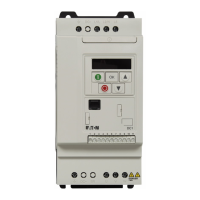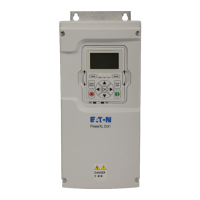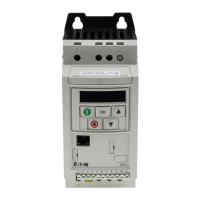8 Modbus RTU
8.2 Modbus parameters
138 DC1 variable frequency drive 12/13 MN04020003Z-EN www.eaton.com
Table 14:Modbus parameters
PNU
ID Access right Designation Value range DS
RUN ro/rw
P-36 164 – rw Variable frequency
drive slave address
0 - 63 1
rw Baud rate 2 = 9.6 kBit/s
3 = 19.2 kBit/s
4 = 38.4 kBit/s
5 = 57.6 kBit/s
6 = 115.2 kBit/s
2
rw TimedOut 0 - 3000 ms 3000 ms
P-12 140 – rw Control level 0
0 Control signal terminals (I/O)
The variable frequency drive will respond directly to signals applied to
the control signal terminals.
1 Keypad (KEYPAD FWD)
The variable frequency drive can only be controlled in the forward
direction if an external or remote control keypad is used.
2 Keypad (KEYPAD FWD/REV)
The variable frequency drive can be controlled in both the forward and
reverse directions if an external or remote control keypad is used. The
keypad can be used to switch between a clockwise rotating field (FWD)
and a anticlockwise rotating field (REV) by pressing the START push-
button.
3 Modbus
Control via Modbus RTU (RS485) with the internal acceleration/deceler-
ation ramps.
4 Modbus
Control via Modbus RTU (RS-485) port; the acceleration/deceleration
ramps will be updated via Modbus.
5 PI controller with external actual value
6 PI controller with external actual value and totalized value of AI1
7 CANopen
Control via CANopen using the internal acceleration/
deceleration ramps
8 CANopen
Control via CANopen, with the acceleration/deceleration ramps being
updated via CANopen
9 Control commands and setpoint values via SmartWire-DT
(DI1 = Hardware enable, P-15: no function)
10 Control commands via SmartWire-DT, setpoint value set locally
(P-15 for local settings)
11 Control commands issued locally, setpoint value via SmartWire-DT
(DI1 = Start/Stop)
12 SmartWire-DT control – control will depend on the configuration in the
event of a loss of communications; automatic switch to local control
13 Control commands and setpoint values via SmartWire-DT
In addition, an enable signal via DI1 and an enable setpoint via DI2

